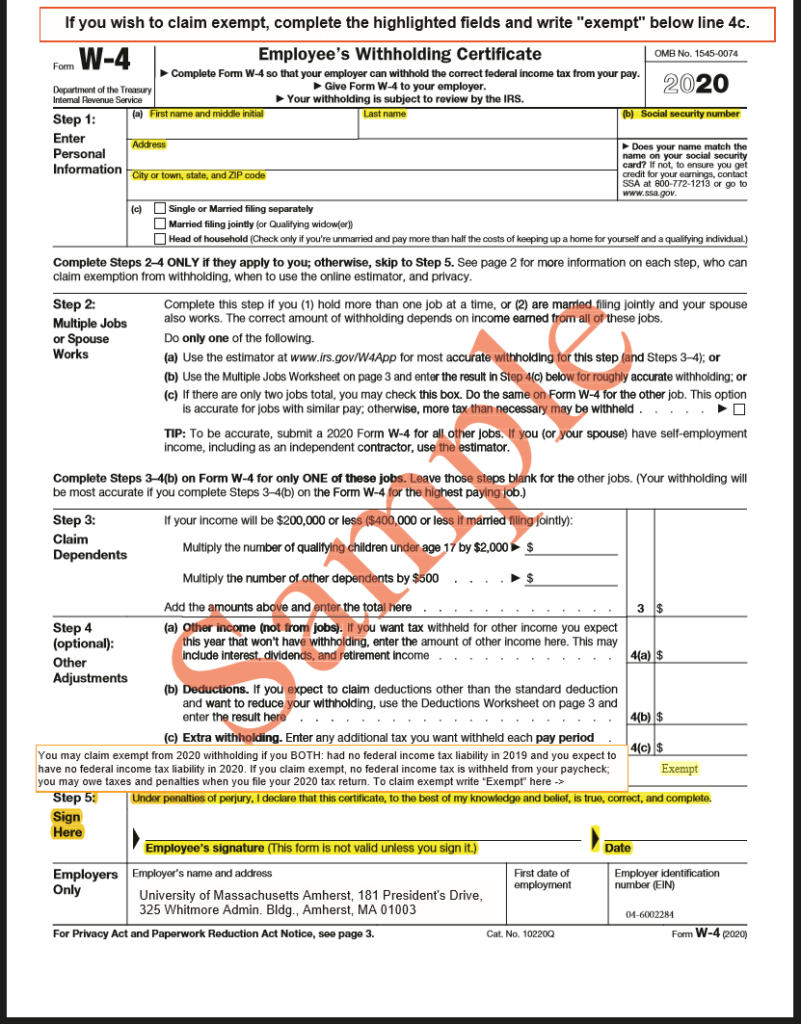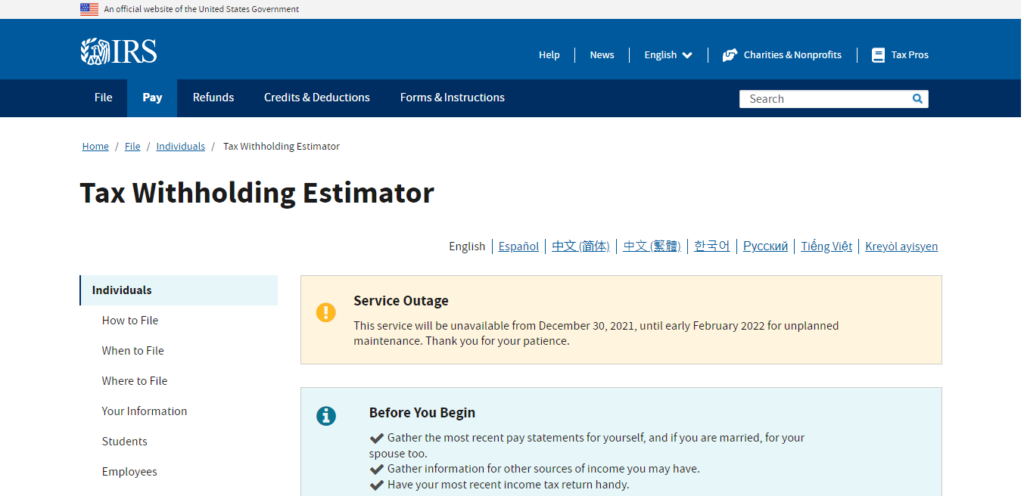Tax-exempt means some or entire transaction, entity, or income of a person isn’t subject to Tax. It means your transaction, entity, income or business is free from federal, state, or local tax. If you have an exemption on taxes for 6 months then you can claim exemption from 2021 federal tax withholding if you had no federal income tax liability in 2020 and you also won’t have any federal income tax liability in 2020.
Key Takeaways
- If your annual income is lower than $12,400/year then you can apply for tax-exempt
- If you are an employee then you can qualify for tax-exempt by changing your W-4 at work
- You have to complete and submit the 2020 W-4 federal tax withholding form for tax exemption
- You should keep in mind that if you go tax-exempt all year then you won’t be eligible for the tax refund
Who Qualifies For Tax-Exempt Status?
Before we dig into the process of filing exemption on taxes for 6 months let’s check out who qualifies for tax-exempt status. If you are an employee then you can exempt federal income tax from your paychecks by changing your W-4 at work. If you qualify for both situations then you can exempt taxes –
1. In the previous year, the employee had the right to a refund of all federal income tax withheld from their wages because they had no tax liability
2. In the current year, the employee expects a refund of all federal income tax withheld because they plan to have no tax liability
Moreover, If your annual income is lower than the below range then you can apply for tax-exempt –
1. $12,400 (Single or Married Filing Separately)
2. $18,650 (Head of Household)
3. $24,800 (Married Filing Jointly or Qualifying Widow(er))
You can also apply for tax-exempt if you receive any income tax which isn’t taxable. There are various types of tax-free income. Some of the common incomes are:
1. Educational assistance from your boss
2. Adoption helps from your employer
3. Child support
4. Payments for caring for children
5. Workers’ compensation
6. Life insurance proceeds
7. Some canceled debts
8. Energy conservation subsidies
9. Municipal bond earnings
10. Gifts
11. Inheritance
12. Accelerated death benefits
13. Disaster relief payments
14. Some withdrawals from a Roth IRA
Process Of Filling Exempt On Taxes For 6 Months
If you want to claim exemption on taxes for six months then you have to complete the 2020 W-4 federal tax withholding certificate. Here is a sample of the 2020 W-4 form –

So, if you wish to claim exemption then follow the below steps:
1. The 2020 W-4 form has 5 parts, in the 1st part you have to write down your first name and last name
2. Then you have to provide your address, city or town, state, ZIP code, etc.
3. In the right-side corner of the form, you have to write down your social security number
4. Now you have to go to the 4th part of the form and below the line 4c you have to write Exempt
5. Then in the 5th part of the form, you have to give your signature and date
How To Fill 2020 W-4 Form
If an employee has evaluated their tax situation and determined that claiming exemption is appropriate for their situation then the employee has to fill out the 2020 W-4 form and submit it. Now follow the below steps:
1st Part
1. In the 1st part, you have to write down your first name and last name
2. Then you have to provide your address, city or town, state, ZIP code, etc.
3. In the right-side corner of the form, you have to write down your social security number
4. From the 1(c) you have to check your anticipated filing status:
a) Single or Married filing separately
b) Married filing jointly (or Qualifying widow(er))
c) Head of household (Check only if you’re unmarried and pay more than half the costs of keeping up a home for yourself and a qualifying individual.)
2nd Part
You have to complete this part if you (1) have more than one job at the same time, or (2) are married filing jointly and you and your spouse both work. If you are eligible then follow the below steps:
1. You have to use the estimator at www.irs.gov/W4App for the most accurate withholding
2. You can also use the Multiple Jobs Worksheet on page 3 of the 2020 W-4 form to calculate the additional tax
3. If you have only two jobs then you have to check the option C on the Form W-4 for the other job

3rd Part
This part of the W-4 form will help you determine the amount of the child tax credit and the credit for other dependents that you may be able to claim when you file your tax return. So, if you want to qualify for the child tax credit, then the child must be under age 17 as of December 31. Moreover, the child must be your dependent and lives with you for more than half the year. Moreover, social security number is also required if you want to qualify for the child tax credit. Now follow the steps:
1. In this step, you have to multiply the number of qualifying children under age 17 by $2,000 and then write down the amount in the form
2. Then, multiply the number of other dependents by $500 and then write down the amount in the form and go to the next step
4th Part
This step is optional and here you have to provide other adjustments like additional income, etc. Now follow the below steps:
1. In the 4(a) you have to enter the total of your other estimated income for the year. You shouldn’t include income from any jobs or self-employment
2. Complete the 4(b) if you expect to claim deductions other than the standard deduction and want to reduce your withholding
3. Then complete the 4(c) if you have any additional tax that you want to be withheld from your pay each pay period
5th Part
In the 5th step of the form, you have to give your signature and date to complete filling out the form
FAQs About Filling Exempt On Taxes
1. What Happens If You Go Tax-Exempt All Year?
If you go tax-exempt all year then you won’t qualify for a tax refund. Though, you can apply for a tax refund if you qualify to claim a refundable tax credit. This process is quite similar to the Earned Income Tax Credit.
2. How Can You Be Penalized For Filing Exempt?
You can be penalized for filing exemptions if you declare withholding allowances on your W-4 to reduce the amount of tax withheld from your paycheck. If you do this type of thing then you could face a tax penalty.
3. How Long Can You Claim Exemption On Your Taxes?
Usually, Form W-4 does not expire so if an employee submits the form once then he is ok. However, if the employee claims he is exempt from federal income tax then he/she have to submit a new Form W-4 each year to keep the exemption.
4. Who Does Not Have To File Federal Taxes?
If a person is under the age of 65 and income is below $12,400/year then that person doesn’t have to file federal taxes.
5. At What Income Do You Have To File Taxes?
You have to file taxes if you are:
1. Single, under the age of 65 and not older or blind, Unearned income was more than $1,050
2. Earned income was more than $12,000
3. Gross income was more than the larger of $1,050 or on earned income up to $11,650 plus $350
4. Single, aged 65 or older or blind, Unearned income was more than $2,650 or $4,250 if you’re both 65 or older and blind
5. Earned income was more than $13,600 or $15,200 if you’re both 65 or older and blind
6. Married, under the age of 65 and not older or blindUnearned income was more than $1,050
7. Earned income was more than $12,000
8. Your gross income was at least $5 and your spouse itemizes deductions
9. Your gross income was more than the larger of $1,050 or your earned income was $11,650 plus $350
10. Married dependents, age 65 or older or blind your gross income was at least $5 and your spouse itemizes deductions
11. Unearned income was more than $2,350 or $3,650 if you are both 65 or older and blind
12. Earned income was more than $13,300 or $14,600 if you are both 65 or older and blind
13. Your gross income was more than $2,350 ($3,650 if both 65 and older and blind) or your earned income was $11,650 plus $1,650 ($2,950 if both 65 or older and blind)
6. Do Senior Citizens Have To File Taxes?
Not all the time, the senior citizens have to file taxes. A senior citizen has to file taxes if he/she is unmarried, at least 65 years of age, and has a gross income of $14,050 or more.
7. Do Pensions Count As Earned Income?
No, pensions don’t count as earned income. Moreover, earned income also doesn’t include annuities, welfare benefits, unemployment compensation, worker’s compensation benefits, or social security benefits.
8. Is It Better To Claim 1 Or 0?
It is better to claim “1” because when you claim 1 on your W-4 form it means your employer will take less money out of your paycheck for federal taxes. On the other hand, if you claim “0” then your employer will take the most amount of tax from your paycheck.
References: 1 https://blog.turbotax.intuit.com/taxes-101/can-i-file-exempt-still-get-a-tax-refund-6695/
References: 2 https://www.hrblock.com/tax-center/irs/tax-responsibilities/am-i-exempt-from-federal-withholding/
Last Updated on October 5, 2022 by Magalie D.

Magalie D. is a Diploma holder in Public Administration & Management from McGill University of Canada. She shares management tips here in MGTBlog when she has nothing to do and gets some free time after working in a multinational company at Toronto.





